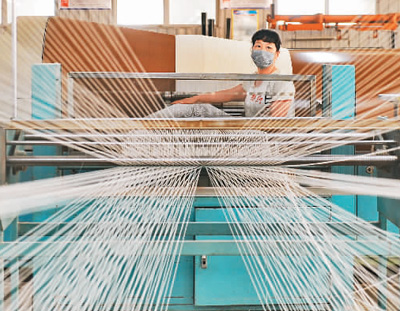


French model Maryse Gaspard dances on the Great Wall during her first visit to China in 1979.
From facing insufficient domestic supply to exporting clothing all over the world, with the equivalent of 4 items of clothing for every person alive today, China has seen remarkable changes in its clothing industry since its reform and opening up.
From little choice of material and style to diversified options such as cotton, flax, silk, leather and chemical fiber, in a variety of designs, Chinese people have witnessed tremendous changes to the development of the country’s clothing industry in just 40 years.
Chinese people born after the year 1990 have become the main driving force of fashion today. As the consumers and disseminators of fashion trends, they help to bring minority fashion brands to the world stage.
However, today's fashion industry in China is in stark contrast with the one found 40 years ago, when a clothing industry of this scale could never have been imagined.
In 1979, famous French fashion designer Pierre Cardin held an eye-catching fashion show in Beijing, impressing Chinese people with a range of colorful garments on stage, while the audience watched on in dark outfits of grey, black, and blue.

A worker in a textile plant in Suning county in Hebei province.
Chinese people didn’t have much choice in clothing at the time, for the country had been faced with a clothing supply shortage, leading to “cloth tickets” being issued to restrict how much cloth each citizen could buy, to guarantee that everyone’s basic clothing needs were met.
With the implementation of reform and opening up, the country stepped into a new era of development and transformation across many industries, clothing included. “Cloth tickets” were no longer necessary, and small clothing factories gradually found their position in the market, thus providing people with more options in style and material.
In 1993, the first China International Clothing & Accessories Fair was held in Beijing, unveiling a variety of new clothing. Since then, foreign clothing brands including Pierre Cardin, Lacoste, Nike, and Adidas have entered the Chinese market, while domestic brands such as Lilanz, Septwolves, Anta, Saint Angelo, and JNBY have also appeared.
In 2000, the WTO helped Chinese clothing brands enter the international market, while more foreign luxury brands began their exploration of the Chinese market. Meanwhile, various domestic clothing companies with market-featured management and operation gradually emerged.
Today, the country is the largest producer of textiles, improving its textile fiber processing capacity from 2.76 million tonnes in 1978 to 54.3 million tonnes in 2017, with its proportion in the global industry rising from 10 percent to over 50 percent.
“In the 40 years since its reform and opening up, China has transformed its textile industry from one which could barely meet its domestic market needs to the largest in the world. China is now the world’s largest producer, consumer, and exporter of textile products. Such achievements in the textile industry would have been impossible without reform and opening up,” said Du Yuzhou, former president of the China National Textile and Apparel Council.
“To cultivate internationally competitive Chinese clothing brands is the unswerving goal of the Chinese textile industry and Chinese clothing companies. Industry organizations are already attempting this goal,” explained Zhao Mingxia, vice director of the industry economic research institute of China National Textile and Apparel Council.
“The primary element for a brand is good quality, while it is also important to have rich cultural and creative elements, as well as a good response to market trends and a reliable social image,” said Zhao. He added that the research of market needs and a good understanding of popular culture are especially important in the fashion world today.
 Fire brigade in Shanghai holds group wedding
Fire brigade in Shanghai holds group wedding Tourists enjoy ice sculptures in Datan Town, north China
Tourists enjoy ice sculptures in Datan Town, north China Sunset scenery of Dayan Pagoda in Xi'an
Sunset scenery of Dayan Pagoda in Xi'an Tourists have fun at scenic spot in Nanlong Town, NW China
Tourists have fun at scenic spot in Nanlong Town, NW China Harbin attracts tourists by making best use of ice in winter
Harbin attracts tourists by making best use of ice in winter In pics: FIS Alpine Ski Women's World Cup Slalom
In pics: FIS Alpine Ski Women's World Cup Slalom Black-necked cranes rest at reservoir in Lhunzhub County, Lhasa
Black-necked cranes rest at reservoir in Lhunzhub County, Lhasa China's FAST telescope will be available to foreign scientists in April
China's FAST telescope will be available to foreign scientists in April "She power" plays indispensable role in poverty alleviation
"She power" plays indispensable role in poverty alleviation Top 10 world news events of People's Daily in 2020
Top 10 world news events of People's Daily in 2020 Top 10 China news events of People's Daily in 2020
Top 10 China news events of People's Daily in 2020 Top 10 media buzzwords of 2020
Top 10 media buzzwords of 2020 Year-ender:10 major tourism stories of 2020
Year-ender:10 major tourism stories of 2020 No interference in Venezuelan issues
No interference in Venezuelan issues
 Biz prepares for trade spat
Biz prepares for trade spat
 Broadcasting Continent
Broadcasting Continent Australia wins Chinese CEOs as US loses
Australia wins Chinese CEOs as US loses